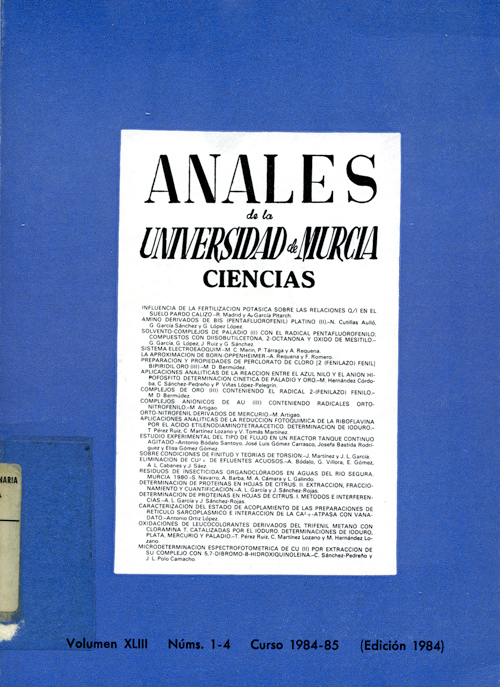Aplicaciones analíticas de la reducción fotoquímica de la riboflavina el ácido etilenodiaminotetraacético. Determinación de ioduro
Abstract
A kinetic study of the photochemical reaction of riboflavin and EDTA (in the absence of oxygen) has been made in connection with development of a new kinetic method for iodide. The reaction is first-order with respect to riboflavin, EDTA and absorbed light-intensity. The rate of photoreduction is strongly pH^dependent, and maximal at about pH 7,5. The photoreduction involves a long-Uved excited state of the vitamin B2 and is dramaticalUy retarded by small amounts of iodide. A tenta'tive mechanism is proposed, and the experimental conditions have been optimized. The variable time method appears to be the most suitable for determination of iodide. A detection limit of 8 [xg/rnl and a casfficient of variation about 3 % can be adhieved. Chloride and bromide do not interfere at levéis below 100-fold mole ratio to iodide. Metal ions do not interfere if enough excess of EDTA is used.Downloads
Downloads
Published
Issue
Section
License
Las obras que se publican en esta revista están sujetas a los siguientes términos:
1. El Servicio de Publicaciones de la Universidad de Murcia (la editorial) conserva los derechos patrimoniales (copyright) de las obras publicadas, y favorece y permite la reutilización de las mismas bajo la licencia de uso indicada en el punto 2.
2. Las obras se publican en la edición electrónica de la revista bajo una licencia Creative Commons Reconocimiento-NoComercial-SinObraDerivada 3.0 España (texto legal). Se pueden copiar, usar, difundir, transmitir y exponer públicamente, siempre que: i) se cite la autoría y la fuente original de su publicación (revista, editorial y URL de la obra); ii) no se usen para fines comerciales; iii) se mencione la existencia y especificaciones de esta licencia de uso.
3. Condiciones de auto-archivo. Se permite y se anima a los autores a difundir electrónicamente las versiones pre-print (versión antes de ser evaluada) y/o post-print (versión evaluada y aceptada para su publicación) de sus obras antes de su publicación, ya que favorece su circulación y difusión más temprana y con ello un posible aumento en su citación y alcance entre la comunidad académica. Color RoMEO: verde.




